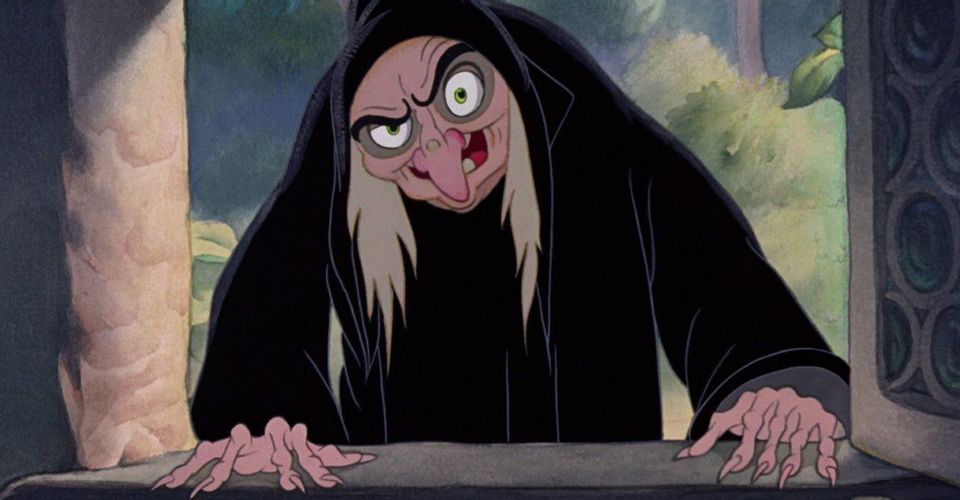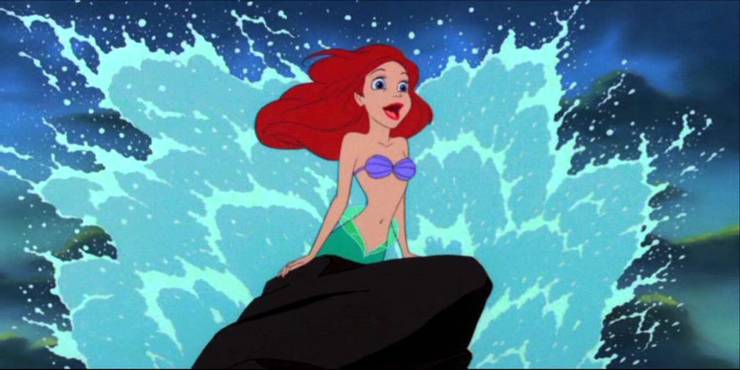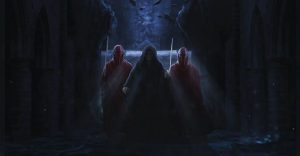15 Disney Movies With Dark Inspirations

Disney has never shied away from dark tendencies. Its plot lines often hinge upon depraved, merciless villains, and death scenes—though often necessary to topple these antagonists—are frequent. But when compared to the twisted stories that inspired the enterprise’s century of captivating, animated children’s films, it’s astonishing the movies emerged so family friendly.
The Jungle Book, for example, was rebooted as a stunning live-action endeavor earlier this year, spawning fresh adaptions for a slew of Disney classics: Beauty and the Beast, The Lion King, and Aladdin are now all in the works. But if viewers knew these stories’ gruesome roots, they might question those PG ratings. For example, in Rudyard Kipling’s original Jungle Book fable, wild boy Mowgli is shunned by civilized society, and teams up with Bagheera, Haithi, and a pack of wolves to destroy an entire village. With that in mind, here are 15 Disney Movies With Dark Inspirations.
15 The Fox and the Hound

The The Fox and the Hound follows the unlikely friendship of a red fox named Tod and his hound dog comrade, Copper. As they grow older, their divergent worlds increasingly pit them against each other as inborn rivals. Despite their best efforts, they eventually succumb to the natural order—that is until a whirlwind chase backs Copper into a dangerous corner, and Tod can’t resist stepping in to save his former friend. Copper later returns the favor, and the two part ways amicably.
While the film doesn’t shy away from violence—death threats and animal attacks abound—its inspiration tells a much more torturous tale. In Daniel P. Mannix’s 1967 novel of the same name, Tod is responsible for the death of Copper’s owner’s favorite dog. In turn, Copper is trained to hunt only Tod and no other foxes. He pursues him so vengefully that Tod eventually collapses and dies from exhaustion. Later, the owner—a longtime alcoholic—tearfully shoots Copper so he can move to a nursing home. Basically, everyone ends up miserable or dead.
14 The Little Mermaid

Disney’s 1989 musical unfolds with grand romance, seaside fantasies, and a soaring, award-winning score. A young, beautiful mermaid named Ariel dreams of living on land, falls in love, and defeats Ursula, an evil underwater witch, so she can sail off into the sunset with her handsome prince. Sure, a little darkness looms beneath the surface—slaying Ursula is the only ticket to a happy ending—but the story is predominantly tame.
Hans Christian Andersen’s 19th century version of The Little Mermaid, however, is much bleaker. In the movie, Ariel simply trades her voice for a pair of land-friendly legs, but here Ursula sells her a potion that makes her feel as if a sword is slicing through her body. The Prince discovers Ariel after she washes to shore and brings her back to his castle, where he forces her to dance for him despite her searing pain. Later, a heartbroken Ariel discovers he’s marrying another woman. In order to reunite with her mermaid family, she must kill the prince and let his blood drip across her feet. Instead, she retreats back into the ocean, transforming into sea foam.
13 Tangled

One of the more modernized stories in the bunch, Tangled debuted in 2010 as a 3D feature. It’s loosely based on the Brothers Grimm’s Rapunzel (1812), and centers around a princess with long, magical hair who’s desperate to escape her secluded tower. She convinces Gothel, her captor, to let a passing vagrant known as Flynn escort her into town for three days, where they happen upon her original kingdom and partake in a celebration. She’s later recaptured, but Flynn (real name Eugene) comes to her rescue. Together, they vanquish Gothel, return to her castle, and eventually marry.
In the Grimms’ take, Rapunzel falls in love with a traveling prince. Dame Gothel is outraged when she discovers their secret romance, and cuts off Rapunzel’s golden locks. She then uses the severed hair to lure the prince to Rapunzel’s tower. She pushes the horrified prince out of the turret and he falls eyes-first onto a thorn bush, leaving him brutally blinded. Despite its morbid trajectory, the story has a hopeful ending: after wandering across the forest for days on end, the prince eventually reunites with Rapunzel, and her tears restore his vision.
12 Mulan

In one of Disney’s more progressive storylines, a young woman named Mulan disguises herself as a man so she can take her elderly father’s place in war. A small dragon, Mushu, helps to protect her throughout battle, and she soon grows into a fierce, proud warrior. Though her captain, Li Shang, discovers her secret, he spares her from execution and instead dismisses her from the army. She doggedly trails her former troops, and cleverly leads them in the final takedown of their enemy Huns.
The 1998 film is based on Hua Mulan, an ancient Chinese legend with a much more tragic ending. Whereas the movie finds Mulan returning to a warm, happy family, the traditional narrative describes her coming back to a broken home: her father has long been dead, and her mother has since remarried. She’s then summoned to the emperor’s palace to become a concubine, and commits suicide in order to escape a life of prostitution.
11 Hercules

The kid-friendly take on Hercules (1997) features a fallen teen god on a mission to become a true hero. Throughout his quest he confronts a number of sinister monsters, including a centaur, Cyclops, and the snake-headed Hydra, all summoned by his father Zeus’ evil and jealous brother Hades. Along the way, Herc falls in love with a smart-mouthed damsel called Meg. Despite her stint as Hades’ minion, Hercules ventures to the underworld to save her soul after her death, and later chooses to remain on Earth by her side rather than ascend to the heavens and live with his immortal family.
As with much of Greek mythology, the original story is sufficiently twisted. Hercules, referred to as Heracles, is not the son of Zeus’s wife Hera, but rather the product of infidelity. For this reason, Hera hates Heracles, and is determined to make his life miserable. He does indeed marry Meg (Megara), but Hera’s torment drives him into a fit of madness, leading him to murder Meg and all of their children. He goes on to wed three more times and has countless affairs with both men and women.
10 Pinocchio

As far as Disney films go, Pinocchio’s 1940 big screen rendition is already pretty dark: misbehaving boys are brought to the deceptively named Pleasure Island, transformed into donkeys, and sold into slave labor. But the central plotline is far less macabre; following a wooden marionette brought to life by the Blue Fairy. The living puppet must overcome his penchant for lying—which famously causes his nose to grow—in order to become a real boy.
The original novel, Carlo Collodi’s Adventures of Pinocchio (1883), paints an even more gruesome picture. When Pinocchio’s virtuous sidekick Jiminy Cricket appears to give the young puppet some moral guidance, Pinocchio fatally squashes him with a mallet. Elsewhere in the story, Pinocchio is nearly drowned, a pack of dogfish half-devour him, and he comes across a fox and cat who steal his money and unsuccessfully attempt to hang him. Eventually, however, he does become a full-fledged, breathing boy, just like in the movie.
9 Peter Pan

Peter Pan’s Neverland may sound like an enchanting escape, but it turns out there just might be an expiration date. Inspired by J.M. Barry’s 1904 play, the 1953 film explores a young English girl named Wendy’s visit to Peter Pan’s grown up-free getaway. Once there, she meets an array of magical characters, including hot-headed pixie Tinker Bell, Native princess Tiger Lily, and vindictive pirate Captain Hook. After an adventurous night, she returns home to London.
In Barry’s version, however, Peter is more spiteful than charming. He doesn’t just dislike adults, he loathes them, and so kills the Lost Boys—his right-hand lads—when they start getting too old. “The boys on the island vary, of course, in numbers, according as they get killed and so on,” reads Barry’s 1911 novel, adapted from the play. “When they seem to be growing up, which is against the rules, Peter thins them out.” In another scene, he breathes intentionally quick, short breaths because Neverland has a saying that every time you breathe, a grown-up dies.
8 The Hunchback of Notre Dame

The kid-friendly take on The Hunchback of Notre Dame is an important lesson that beauty is only skin deep. The 1996 animated drama features a deformed bell-ringer, Quasimodo, who struggles to fit into 15th century French society. After twenty years in an isolated cathedral, three living gargoyles—Quasimodo’s only companions—convince him to venture into town for the Festival of Fools. There, he encounters a kind gypsy named Esmerelda. She saves him from ridicule, and the two become friends. Eventually, they fall in love.
The original Hunchback of Notre Dame reads like a demented spin on Romeo and Juliet. In Victor Hugo’s 1831 novel, Quasimodo’s feelings for Esmerelda are unrequited. Bitter from rejection, he rats her out to the French police, who hang her in the public square for her crimes. After her death, a guilt-ridden Quasimodo sneaks into Esmerelda’s grave, curls up next to her cold, dead body, and starves to death. Their bodies are discovered 18 months later, and when they try to separate them, their skeletons turn to dust.
7 Pocahontas

As some may know, Pocahontas is based on a real historical figure. In Disney’s 1995 retelling, she is the strong, free-spirited daughter of Powhatan Chief Patawan. When English settlers arrive to colonize her native land, she ends up falling in love with the handsome John Smith. After a lengthy battle, she negotiates peace between his British compatriots and her tribe.
In reality, Pocahontas was around 10 or 12-years-old when the settlers arrived, and Smith was about 30. The pair never had a romantic relationship, though there is evidence from Smith’s diaries that he raped and impregnated her. During war, she was kidnapped and held in captive. She later married an Englishman named John Rolfe, and returned with him to Britain, where she was allegedly showcased as a civilized savage. She died of unknown causes at the age of 21—not quite the love story Disney made it out to be.
6 Beauty and the Beast

Beauty and the Beast was another moral tale, illustrating the importance of giving people a chance. The 1991 musical follows a young, beautiful bookworm named Belle. One day, her horse leads her to a castle where a bewitched Beast is holding her father captive. She offers to take her father’s place, and he reluctantly agrees. Over time, the Beast develops feelings for Belle, which she gradually returns. She confesses her love, and he’s transformed back into the prince he once was.
Disney’s version doesn’t veer all that far from Jeanne-Marie Leprince de Beaumont’s 18th century fairytale, but it does exclude a few malicious details. In de Beaumont’s account, Belle has two wicked elder sisters. During her stay in the castle, the Beast grants her permission to visit home for a week. Her sisters are immediately envious of the fine jewelry and clothing she returns with, and attempt to keep her past the Beast’s seven-day deadline in the hope that he’ll be so furious he eats her alive.
5 Aladdin and the King of Thieves

The first installment of Disney favorite Aladdin draws from relatively modest source material, but its second sequel, Aladdin and the King of Thieves, cranks the psychosis to 10. The Mickey Mouse adaption picks up at Jasmine and Aladdin’s wedding, when a band of thieves raid the celebration. Aladdin discovers the robbers’ leader is his long-lost father, and the two embark on a treasure hunt only to be foiled by his father’s criminal battalion. In the end, his father realizes Aladdin is his ultimate prize and abandons his illicit past.
Ali Babi and the Forty Thieves, its 18th century storybook inspiration, holds a much different fate for Aladdin’s father. Instead of reuniting with his son and overcoming his life of greed, he’s murdered by a group of bandits when they discover him in their hideout. They dismember him and scatter his body parts at the entrance of their cave to warn unwanted visitors. His brother brings his body to a tailor to be stitched together and sent back to his family so they’ll think he died of natural causes.
4 Sleeping Beauty

The 1959 animated fantasy Sleeping Beauty follows Princess Aurora, a young maiden cursed at birth to fall into a deep, enchanted slumber should she prick her finger on a spindle. Her parents send her to hide in a woodcutter’s cottage, where she meets and falls in love with Phillip, a handsome young Prince to whom she was unknowingly betrothed many years ago. An evil witch tricks Aurora into pricking her finger and kidnaps her newfound suitor, but a group of fairies release him and he wakes Aurora with true love’s kiss.
The cinematic adaptation is officially based on Charles Parrault’ The Beauty Sleeping in the Wood and Little Briar Rose by the Brothers Grimm, both of which were inspired by Giambattista Basile’s 1634 fairytale Sun, Moon, and Talia. In Basile’s work, a traveling king is unable to wake Aurora (then called Talia) because a splinter in her finger is causing the coma. Overcome by her beauty, he rapes her while she’s unconscious and leaves. She later gives birth to twins in her sleep, and they wake her by sucking out the splinter. The King returns, but has since married, and goes back to his castle. His wife finds out, summons Talia to her kingdom and attempts to murder her, but the King thwarts the plan. Talia then marries the (rapist) King.
3 Cinderella

The Disney spin on Cinderella (1950) is an uplifting tale about a kind, gentle girl who finds love with a prince and escapes her tortured home. After both of her parents die, Cinderella is left to live with her evil stepmother and sisters, who confine her to a menial life as their personal maid. She’s gifted with a Fairy Godmother who helps her attend a royal ball, where she meets her husband-to-be and eventually lives happily ever after.
The Brothers Grimm’s version, however, is flat-out grisly. When the prince visits Cinderella’s home with her lost glass slipper, her jealous stepsisters don’t just try to squeeze their feet into the shoes: one cuts off her own toes, and the other slices off her own heel. Cinderella is no angel, either. At her wedding to the Prince, she orders her little bird friends to fly down and peck out the sisters’ eyes.
2 Snow White

Disney made its animated debut with Snow White and the Seven Dwarfs in 1937. The film follows a stunning royal heir and her vein, envious stepmother. When Snow White surpasses her stepmother’s beauty, the Queen orders her Hunstman to take her into the woods and kill her. Instead, he lets Snow White go, and urges her to flee into the woods. Later, the Queen discovers Snow White is still alive and well and tricks her into biting a poison apple, forcing her into an eternal sleep. Similar to Sleeping Beauty, a prince comes across Snow White and wakes her with love’s first kiss.
In the original 19th century fairytale—again from the Brothers Grimm—Snow White is much more vengeful. She invites her hateful stepmother to her wedding with the prince. Once there, she gives her stepmother a pair of hot iron shoes, and forces her to dance to death in front of the wedding party.
1 The Lion King

There are few scenes more traumatizing than Mufasa’s tragic death during The Lion King, but the story’s roots are far bloodier. Though many have traced the beloved 1994 film to Japenese manga series Kimba The White Lion, Disney insists it was influenced by Shakespeare’s Hamlet. In the movie, pride leader Mufasa is killed by his brother Scar. He manipulates Mufasa’s son, Simba, into believing it was his fault, and convinces him to retreat into exile. Years later, Simba returns, discovers the truth, and claims his rightful heir to the kingdom. He spares Scar’s life, but banishes him from the Pride Lands.
In Shakespeare’s play, Claudius (Scar) murders his brother, King Hamlet (Mufasa), steals his crown, and marries his wife. Later, the King comes to his son (Simba) as a ghost and instructs him to avenge his death by slaying Claudius and seizing the throne. After many soliloquies and lots of maniacal plotting, everyone ends up dead.
—
Does knowing the origins of these Disney movies ruin them for you? Let us know in the comments.
About The Author

















